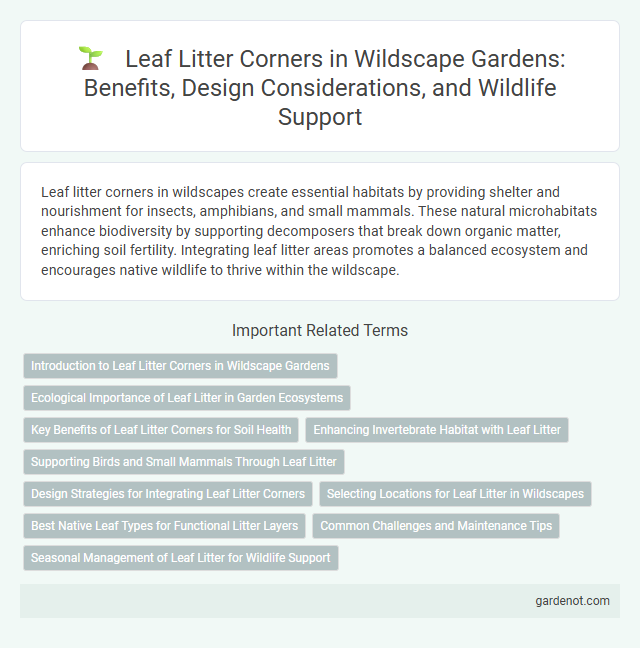Leaf litter corners in wildscapes create essential habitats by providing shelter and nourishment for insects, amphibians, and small mammals. These natural microhabitats enhance biodiversity by supporting decomposers that break down organic matter, enriching soil fertility. Integrating leaf litter areas promotes a balanced ecosystem and encourages native wildlife to thrive within the wildscape.
Introduction to Leaf Litter Corners in Wildscape Gardens
Leaf litter corners in Wildscape gardens create vital habitats by accumulating decomposing plant material that supports diverse invertebrates and microorganisms. These areas enhance soil fertility and promote nutrient cycling essential for native vegetation growth. Integrating leaf litter corners encourages biodiversity, improves ecosystem resilience, and fosters natural pest control within the garden environment.
Ecological Importance of Leaf Litter in Garden Ecosystems
Leaf litter in garden ecosystems plays a critical role by providing essential habitat and nutrient cycling, supporting diverse soil microorganisms and invertebrates. This natural mulch improves soil structure, moisture retention, and fertility, fostering plant growth and biodiversity within wildscape gardens. Maintaining a healthy leaf litter corner enhances ecological balance by promoting decomposition processes crucial for sustaining food webs.
Key Benefits of Leaf Litter Corners for Soil Health
Leaf litter corners enhance soil health by improving moisture retention, nutrient cycling, and fostering beneficial microbial activity. Decomposing organic matter enriches the soil with essential nutrients, promoting plant growth and increasing soil fertility. These areas also support diverse soil fauna, which aerate the soil and enhance its structure for long-term ecosystem stability.
Enhancing Invertebrate Habitat with Leaf Litter
Leaf litter corner plays a crucial role in enhancing invertebrate habitat by providing essential shelter, moisture retention, and a rich source of decaying organic matter that supports diverse invertebrate communities. This layer of leaf litter fosters increased biodiversity by creating microhabitats for beetles, spiders, ants, and decomposers like earthworms and fungi, which contribute to nutrient cycling and soil health. Incorporating leaf litter in wildscape designs promotes sustainable ecosystems by mimicking natural forest floor conditions that support the life cycles of numerous beneficial invertebrates.
Supporting Birds and Small Mammals Through Leaf Litter
Leaf litter corners provide essential habitats by offering shelter and foraging opportunities for birds and small mammals, enhancing biodiversity. The decomposing leaves enrich soil quality and support insect populations that serve as vital food sources. This natural environment promotes a thriving ecosystem crucial for wildlife survival and ecosystem health in Wildscape gardens.
Design Strategies for Integrating Leaf Litter Corners
Design strategies for integrating leaf litter corners emphasize creating microhabitats that mimic natural forest floors by layering diverse organic materials such as fallen leaves, twigs, and bark to support invertebrate biodiversity. Incorporating native plant species around these corners enhances microclimate regulation and facilitates nutrient cycling, promoting ecosystem health within the wildscape. Structural elements like logs, stones, and shaded areas increase habitat complexity, attracting various fauna and maintaining ecological balance.
Selecting Locations for Leaf Litter in Wildscapes
Selecting locations for leaf litter in wildscapes enhances biodiversity by creating microhabitats for insects, amphibians, and fungi. Ideal spots include shaded areas near native plants, where moisture retention supports decomposer activity and nutrient cycling. Avoid high-traffic zones to prevent disturbance and maximize habitat stability.
Best Native Leaf Types for Functional Litter Layers
Oak leaves, maple leaves, and beech leaves are among the best native leaf types for creating functional litter layers in wildscapes. These leaves decompose slowly, providing essential nutrients and habitat for soil microbes and invertebrates. Incorporating a variety of native leaves enhances biodiversity and supports healthy ecosystem processes in garden and wildscape environments.
Common Challenges and Maintenance Tips
Leaf litter corners in wildscapes often face challenges such as moisture retention leading to mold growth and accumulation of pests that can disrupt local ecosystems. Proper maintenance involves regular removal of excess leaf debris to prevent fungal outbreaks and promoting airflow to reduce dampness. Incorporating native plants and mulching techniques supports decomposition while maintaining habitat balance and soil health.
Seasonal Management of Leaf Litter for Wildlife Support
Leaf litter management in Wildscape's Leaf Litter Corner enhances habitat quality by providing essential cover and nutrient-rich soil for wildlife during different seasons. Seasonal raking and controlled decomposition ensure optimal moisture retention and temperature regulation, supporting amphibians, insects, and small mammals. Strategic layering mimics natural cycles, promoting biodiversity and ecosystem resilience throughout the year.
Leaf litter corner Infographic

 gardenot.com
gardenot.com